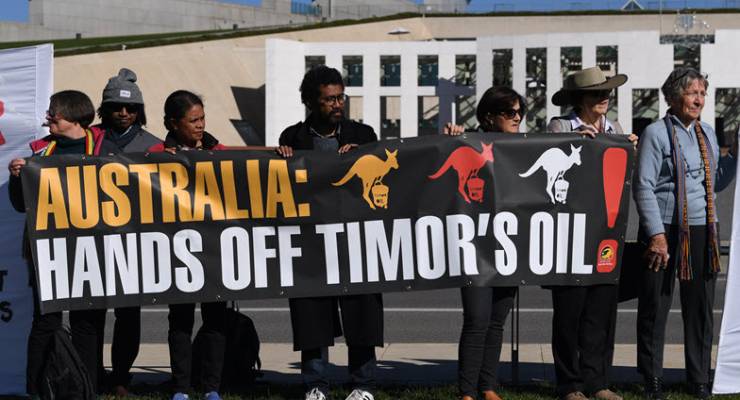
Australia’s agreement with East Timor to settle a permanent maritime boundary in the Timor Sea appears to bring to an end a long-running and often bitter dispute, which has marred relations between the two countries. Indeed, with this deal, Australia has again bullied its tiny near neighbor into acquiescing to a deal that is less than what East Timor believed it was entitled to.
East Timor has agreed to the lesser deal because it has been facing major budget cuts to stave off medium-term economic collapse. Without a deal, the country could have been bankrupt before the end of the 2020s. Even under the agreement, revenues are unlikely to flow from the field until around that time.
The agreement now provides certainty around the development of the Greater Sunrise gas and oil field, and hence should help secure East Timor’s economic future. It was the development of this field that was always at the heart of East Timor’s dispute with Australia.
The agreement falls short of East Timor’s original claim, that an equidistant boundary between Australia and East Timor would place all of the Timor Sea oil and gas fields, including Greater Sunrise, within East Timorese territorial waters. That claim was based on the international Convention on the Law of the Sea.
One difficulty with that claim is that it would have required an alteration to Indonesia’s boundaries with Australia on either side of the Timor Sea. It now appears that Indonesia’s existing boundaries will be retained, meaning East Timor’s new boundary will be narrower than originally conceived and less than identified under the Convention of the Law of the Sea.
[Are we the bad guys? Australia’s ruthless past with East Timor]
The narrower boundary will also leave a significant part of the Greater Sunrise field within Australian waters. The Greater Sunrise field was variously estimated to be worth up to $50 billion dollars at the peak of world oil and gas prices. Those prices have since declined and a new valuation will depend on what forward contracts can be signed.
While no specific details are available, the agreement that has been reached refers to a “pathway to the development of the [Greater Sunrise] resource, and the sharing of the resulting revenue”. Australia had previously offered East Timor a 50-50 split of revenue from the Greater Sunrise field, so it is expected that the agreement will increase East Timor’s share of revenues.
The agreement also leaves open the question of the “pathway to the development” of the field. East Timor had argued for the processing of the natural gas at a refinery to be built on its southern coast.
The Greater Sunrise concession holder, Woodside Petroleum, argued against the south coast proposal, saying that it would require the construction of a pipeline across the Timor Trough, which is more than 3000 metres deep. Woodside also said that the refinery and infrastructure was economically unviable on East Timor’s under-developed south coast.
Instead, Woodside proposed building a floating refining platform, which East Timor rejected, leading to the dispute. A further refining option is to back-fill existing Timor Sea oil pipelines as other local oil fields run dry in the next three to five years. Details on the place of refining will become clear when the agreement is made public in October.
East Timor currently survives by accessing funds from its petroleum sovereign wealth fund, currently worth about $16 billion. This funds almost all government spending and underwrites around 92% of the East Timor economy.
The intention was that the petroleum fund would be drawn on at a sustainable, interest-only rate. However, since 2008, successive budgets have exceeded sustainable income by around 200%, drawing on capital as well as interest.
Given that existing Timor Sea oil field are expected to be depleted by 2020-22, if East Timor were to continue spending at that rate, it would be bankrupt before the end of the next decade. Facing significant budget cuts in the face of declining revenues, East Timor has been forced to accept the lesser deal.
This follows Australia’s position in 2002, in which then-foreign minister Alexander Downer brow-beat East Timor prime minister Mari Alkatiri into accepting a division of the Timor Sea between the two countries. If Alkatiri had not accepted that agreement, the new and deeply impoverished nation would have been immediately bankrupted.
[East Timor is mad as hell, and it’s our fault]
While Xanana Gusmao was prime minister, he had argued forcefully for an equidistant boundary and full rights to the Greater Sunrise field. Fretilin’s leader, Mari Alkatiri, had said that he was more amenable to a compromise, to help ensure that East Timor could adequately fund its future.
Xanana Gusmao’s CNRT lost government in the July elections, with Fretilin leading the new government, expected to be sworn in this week. Gusmao was, however, retained by Alkatiri to negotiate the Timor Sea issue.
Alkatiri now being in charge, and facing further cuts to the next budget, explains East Timor’s sudden shift of position. So East Timor now has a sovereign border and can expect a new flow of revenue once the Greater Sunrise field is developed and comes on stream.
Australia forced an inequitable deal with East Timor in 2002, was taken to the Court of Arbitration over this issue and has now forced East Timor to submit to another compromise agreement. It may be that the agreement heralds an improvement in Australia-East Timor bilateral relations but, in reaching it, Australia has little to be proud of.








I’ve always detested Downer for what he did to Timor-Leste, especially after having seen for myself, by visiting there, how needy the country is. Hard to be proud of Australia at the moment.
Any price on bumBoilShlernt replicating Great Gough’s ignoring Timor Leste’s plight?
How ironic that it was Rattus Mendacious who proved to be the liberator of that tiny abused, abandoned & brutalised segment of humanity.